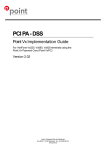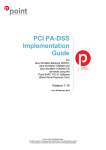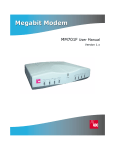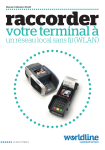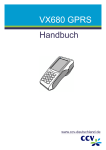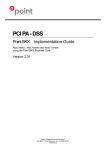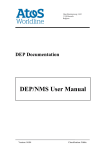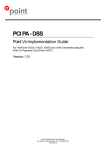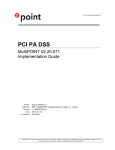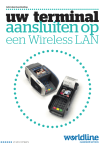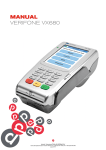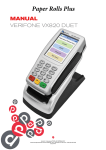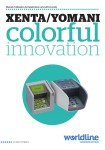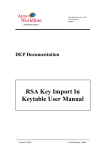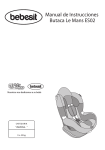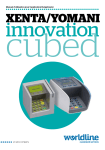Download Point PA-DSS Implementation Guide
Transcript
Point PA-DSS Implementation Guide Banksys Yomani 1.04 VeriFone Vx670, Vx520, Vx680, Vx820 & Ux300 VPFIPA0301 Point Transaction Systems Oy | Vanha Nurmijärventie 62 | FI-01670 VANTAA | www.point.fi Point PA-DSS Implementation Guide Version 1.7 Confid: Public Contents 1 Revision history 1 2 Introduction 2 3 Document use 2 3.1 4 Important notes Summary of requirements 2 3 4.1 Do not retain full magnetic stripe, card verification code or value (CAV2, CID, CVC2, CVV2), or PIN block data 3 4.2 Protect stored cardholder data 4 4.3 Provide secure authentication features 7 4.4 Log payment application activity 8 4.5 Develop secure payment applications 9 4.6 Protect wireless transmissions 11 4.7 Facilitate secure network implementation 12 4.8 Cardholder data must never be stored on a server connected to the Internet 13 4.9 Facilitate secure remote access to payment application 13 4.10 Encrypt sensitive traffic over public networks 14 4.11 Encrypt all non-console administrative access 15 5 Point application key management 16 6 Implementation Guide reviews and updates 16 7 Terminology 16 8 References 18 Point Transaction Systems Oy | Vanha Nurmijärventie 62 | FI-01670 VANTAA | www.point.fi Point PA-DSS Implementation Guide Version 1.7 1 Confid: Public Page 1 / 18 Revision history Version Author Date Comments 0.1 Pekka Ylitalo 1.2.2010 Initial draft 0.2 Pekka Ylitalo 5.2.2010 Review by Martin Gutekunst 0.3 Pekka Ylitalo 26.2.2010 Updated after review by Acertigo 0.4 Lauri Mäkinen 27.4.2010 Made YOMANI related changes to req. 1.1.5 and chapter 5 1.0 Lauri Mäkinen 4.5.2010 Updated version number to 1.0 1.1 Pekka Ylitalo 25.8.2010 Made changes to req. 1.1.4 and chapter 6 1.2 Pekka Ylitalo 8.12.2011 Point application firewall requirement changes to chapter 4.3 req. 6 and chapter 4.4 req. 9 and 10 1.3 Kimmo Heiskanen 10.5.2013 Added multiple requirement definitions to meet PADSS v2.0 audit requirements 1.4 Pekka Ylitalo 16.9.2013 Implementation guide updated and finalized according to PA-DSS v2.0 implementation guide requirements 1.5 Pekka Ylitalo 15.10.2013 Minor updates after review by TÜV SÜD 1.6 Pekka Ylitalo 4.2.2014 Added VeriFone terminal models to the title page 1.7 Pekka Ylitalo 2.7.2014 Implementation guide updated according to PA-DSS v3.0 implementation guide requirements Point Transaction Systems Oy | Vanha Nurmijärventie 62 | FI-01670 VANTAA | www.point.fi Point PA-DSS Implementation Guide Version 1.7 2 Confid: Public Page 2 / 18 Introduction The Payment Card Industry Data Security Standard (PCI DSS) defines a set of requirements for the configuration, operation, and security of payment card transactions in Your business. The requirements are designed for use by assessors conducting onsite reviews and for merchants who must validate compliance with the PCI DSS. The Payment Card Industry has also set the requirements for software applications that store, process or transmit cardholder data. These requirements are defined by the Payment Card Industry Payment Application Data Security Standard (PCI PA-DSS). In order to facilitate for You to get a PCI DSS assessment the Point application has been approved by PCI to comply with the PCI PA-DSS requirements. Failure to comply with these standards can result in significant fines if a security breach should occur. For more details about PCI DSS and PCI PA-DSS, please see the following link: http://www.pcisecuritystandards.org 3 Document use This PA-DSS Implementation Guide contains information about the Point application. Point Transaction Systems Oy does not possess the authority to state that a merchant may be deemed “PCI Compliant”. Each merchant is responsible for creating a PCI-compliant environment. The purpose of this guide is to provide the information needed during installation and operation of the Point application in a manner that will support a merchant’s PCI DSS compliance efforts. 3.1 Important notes • This guide refers to Point application versions on the PCI web site “List of Validated Payment Applications” that have been validated in accordance with PCI PA-DSS. If You cannot find the version running on Your Point terminal on that list please contact our helpdesk at Point in order to upgrade Your terminal • Both the System Installer and the controlling merchant must read this document • This document must also be used when training ECR integrators/resellers at initial workshops Point Transaction Systems Oy | Vanha Nurmijärventie 62 | FI-01670 VANTAA | www.point.fi Point PA-DSS Implementation Guide Version 1.7 4 Confid: Public Page 3 / 18 Summary of requirements This summary covers shortly the PCI DSS/PA-DSS requirements that have a related PA-DSS Implementation Guide topic. It also explains how the requirement is handled in the Point application and also explains the requirement from Your aspect. The complete PCI DSS and PA-DSS documentation can be found at: http://www.pcisecuritystandards.org 4.1 Do not retain full magnetic stripe, card verification code or value (CAV2, CID, CVC2, CVV2), or PIN block data Requirement 1.1.4: Delete sensitive authentication data stored by previous payment application versions. 1. What the requirement says Securely delete any track data (from the magnetic stripe or equivalent data contained on a chip), card verification values or codes, and PINs or PIN block data stored by previous versions of the payment application, in accordance with industry-accepted standards for secure deletion, as defined, for example by the list of approved products maintained by the National Security Agency, or by other State or National standards or regulations. 2. How the Point application meets this requirement No specific setup for the Point application is required. The Point application does not store any historical data so removal of historical data is not needed. 3. What this means to You You must make sure that historical data (magnetic stripe data, cardholder data and CVV2s) is removed from all other storage devices used in Your systems, ECRs, PCs, servers etc. For further details please refer to the appropriate vendor. Removal of historical data is absolutely necessary for PCI DSS compliance. Requirement 1.1.5: Delete any sensitive authentication data (pre-authorization) gathered as a result of troubleshooting the payment application. 1. What the requirement says Do not store sensitive authentication data on vendor systems. If any sensitive authentication data (pre-authorization data) must be used for debugging or troubleshooting purposes, ensure the following: • Sensitive authentication data is collected only when needed to solve a specific problem. • Such data is stored in a specific, known location with limited access. • The minimum amount of data is collected as needed to solve a specific problem. Point Transaction Systems Oy | Vanha Nurmijärventie 62 | FI-01670 VANTAA | www.point.fi Point PA-DSS Implementation Guide Version 1.7 Confid: Public Page 4 / 18 • Sensitive authentication data is encrypted with strong cryptography while stored. • Data is securely deleted immediately after use, including from: - Log files - Debugging files - Other data sources 2. How the Point application meets this requirement Generally troubleshooting is not done on production terminals. However, if logs are written, no sensitive data is included in them. For the Yomani terminal logging level may be raised to a higher level from the application. If the logging level is for any reason raised to a higher level PAN’s are stored in truncated format. Logs can only be sent from terminal to a Point backend and thus be examined only by Point personnel. Troubleshooting logs storage time is 20 days. 3. What this means to You No actions needed. 4.2 Protect stored cardholder data Requirement 2.1: Securely delete cardholder data after customer-defined retention period. 1. What the requirement says Software vendor must provide guidance to customers regarding purging of cardholder data after expiration of customer-defined retention period. 2. How the Point application meets this requirement All cardholder data is automatically erased during the nightly batch sending or if manual batch sending is done. Below is a list of all the locations where the payment application stores cardholder data: VeriFone terminals: o FILETRANSLIST.LST, PAYMENTS.BLS and EcrTrnBackup.LST Banksys Yomani: o /usr/paymentapp/logs, /usr/paymentapp/store/pending, /usr/paymentapp/store/sent, /usr/paymentapp/store/lastFailed, /usr/paymentapp/blacklist_ranges.bin and /usr/paymentapp/blacklist_singles.bin Point Transaction Systems Oy | Vanha Nurmijärventie 62 | FI-01670 VANTAA | www.point.fi Point PA-DSS Implementation Guide Version 1.7 Confid: Public Page 5 / 18 No activity is necessary to prevent inadvertent capture or retention of cardholder data. For example, system backup or restore points. 3. What this means to You All cardholder data is automatically erased during the nightly batch sending. If You want to do this operation manually it is possible. Please refer to the Point application user manual on how to send the batch manually. This will erase all cardholder data. Requirement 2.2: Mask PAN when displayed so only personnel with a business need can see the full PAN. 1. What the requirement says Mask PAN when displayed (the first six and last four digits are the maximum number of digits to be displayed), such that only personnel with a legitimate business need can see the full PAN. 2. How the Point application meets this requirement PAN is always automatically masked. 3. What this means to You No actions needed. Requirement 2.3: Render PAN unreadable anywhere it is stored (including data on portable digital media, backup media, and in logs). 1.What the requirement says Render PAN unreadable anywhere it is stored (including data on portable digital media, backup media, and in logs) by using any of the following approaches: • One-way hashes based on strong cryptography (hash must be of the entire PAN) • Truncation (hashing cannot be used to replace the truncated segment of PAN) • Index tokens and pads (pads must be securely stored) • Strong cryptography with associated key-management processes and procedures. 2.How the Point application meets this requirement PAN is always automatically rendered unreadable anywhere it is stored. 3.What this means to You No actions needed. Point Transaction Systems Oy | Vanha Nurmijärventie 62 | FI-01670 VANTAA | www.point.fi Point PA-DSS Implementation Guide Version 1.7 Confid: Public Page 6 / 18 Requirement 2.4: Protect keys used to secure cardholder data against disclosure and misuse. 1.What the requirement says Payment application must protect any keys used to secure cardholder data against disclosure and misuse. 2.How the Point application meets this requirement Access to the encryption keys is prevented. Keys are stored in special safe memory. 3.What this means to You No actions needed. Requirement 2.5: Implement key management processes and procedures for cryptographic keys used for encryption of cardholder data. 1. What the requirement says Payment application must implement key management processes and procedures for cryptographic keys used for encryption of cardholder data. 2. How the Point application meets this requirement The KEY management process is automatic and controlled only by the Point application. See chapter 5 for detailed information about key management and cryptographic material removal. 3. What this means to You No actions needed. Requirement 2.5.1 – 2.5.7: Implement secure key-management functions. 1.What the requirement says Generation of strong cryptographic keys. Secure cryptographic key distribution. Secure cryptographic key storage. Cryptographic key changes for keys that have reached the end of their crypto period (for example, after a defined period of time has passed and/or after a certain amount of ciphertext has been produced by a given key), as defined by the associated application vendor or key owner, and based on industry best practices and guidelines. Retirement or replacement of keys (for example: by archiving, destruction, and/or revocation as applicable) as deemed necessary when the integrity of the key has been weakened (for example, departure of an employee with knowledge of a clear-text key component, etc.) or keys are suspected of being compromised. Point Transaction Systems Oy | Vanha Nurmijärventie 62 | FI-01670 VANTAA | www.point.fi Point PA-DSS Implementation Guide Version 1.7 Confid: Public Page 7 / 18 If the payment application supports manual clear-text cryptographic key-management operations, these operations must enforce split knowledge and dual control. Prevention of unauthorized substitution of cryptographic keys. 2.How the Point application meets this requirement The KEY management process is automatic and controlled only by the Point application. See chapter 5 for detailed information about key management and cryptographic material removal. 3.What this means to You No actions needed. Requirement 2.6: Provide a mechanism to render irretrievable cryptographic key material or cryptograms stored by the payment application. 1. What the requirement says Provide a mechanism to render irretrievable any cryptographic key material or cryptogram stored by the payment application, in accordance with industry-accepted standards. These are cryptographic keys used to encrypt or verify cardholder data. 2. How the Point application meets this requirement All cryptographic material must be removed and it is absolutely necessary for PCI DSS compliance. The removal of this material is automatically handled by the Point application so You do not need to take any action. See chapter 5 for detailed information about key management and cryptographic material removal. 3. What this means to You No actions needed. 4.3 Provide secure authentication features Requirement 3.1: Use unique user IDs and secure authentication for administrative access and access to cardholder data. 1. What the requirement says The payment application must support and enforce the use of unique user IDs and secure authentication for all administrative access and for all access to cardholder data. Secure authentication must be enforced to all accounts generated or managed by the application by the completion of installation and for subsequent changes after installation. Point Transaction Systems Oy | Vanha Nurmijärventie 62 | FI-01670 VANTAA | www.point.fi Point PA-DSS Implementation Guide Version 1.7 Confid: Public Page 8 / 18 2. How the Point application meets this requirement No administrative access to the Point application is possible. 3. What this means to You No actions needed. Requirement 3.2: Use unique user IDs and secure authentication for access to PCs, servers, and databases with payment applications. 1. What the requirement says Software vendor must provide guidance to customers that all access to PCs, servers, and databases with payment applications must require a unique user ID and secure authentication. 2. How the Point application meets this requirement The Point application does not provide any accounts or access to critical data. 3. What this means to You No actions needed. 4.4 Log payment application activity Requirement 4.1: Implement automated audit trails. 1. What the requirement says At the completion of the installation process, the “out of the box” default installation of the payment application must log all user access and be able to link all activities to individual users. 2. How the Point application meets this requirement The Point application does not allow making any changes relevant to the payment functionality. Because of this no activity can be performed which would need logging/auditing. 3. What this means to You No actions needed. Requirement 4.4: Facilitate centralized logging. 1. What the requirement says Payment application must facilitate centralized logging Point Transaction Systems Oy | Vanha Nurmijärventie 62 | FI-01670 VANTAA | www.point.fi Point PA-DSS Implementation Guide Version 1.7 Confid: Public Page 9 / 18 2. How the Point application meets this requirement The Point application provides a functionality to send logs into an arbitrary log server, in general a log server maintained by the merchant. For the Yomani terminal troubleshooting logs are sent separately from the payment terminal if requested by Point backend system, or by activating troubleshooting log sending from the terminal. 3. What this means to You If You want to setup an arbitrary log server, please refer to the Point application user manual on how to do this. If You are using a Yomani terminal please contact Point customer service. 4.5 Develop secure payment applications Requirement 5.4.4: Implement and communicate application versioning methodology. 1.What the requirement says The vendor’s published versioning methodology must be communicated to customers and integrators/resellers. 2.How the Point application meets this requirement The Point application uses the following version methodologies in all releases: For VeriFone terminals the version number has two parts: XXYY.RR Version number component: Description: XX Major Version Changes if: Major changes to payment process, change that impacts security functionality. Requires a full PA-DSS assessment. Major OS update, operating systems is dramatically changed YY Minor version Large feature additions, terminal model additions, any cause of deltaassessment, partial audit, re-audit due to expiration etc. RR Wildcard / Revision Changes that have impact on application functionality but no impact on security or PA-DSS requirements Changes have no impact on the functionality of the application or it's Point Transaction Systems Oy | Vanha Nurmijärventie 62 | FI-01670 VANTAA | www.point.fi Point PA-DSS Implementation Guide Version 1.7 Confid: Public Page 10 / 18 dependencies – for example cosmetic changes Smaller operating system patches Additions that don't touch PA-DSS, revision exists for internal use Revision number doesn't reset on Major & Minor updates, but increases continuously For Yomani terminals the version number has four parts: X.YY.RRRR.SSSS Version number component: Description: X Major Version Major changes to payment process, change that impacts security functionality. Requires a full PA-DSS assessment. YY Minor version Feature additions, terminal model additions, operating system updates, any cause of delta-assessment, partial audit, re-audit due to expiration etc. RRRR Wildcard / Revision Changes that have impact on application functionality but no impact on security or PA-DSS requirements Changes have no impact on the functionality of the application or it's dependencies - cosmetic changes for instance Additions that don't touch PA-DSS, revision exists for internal use Revision number doesn't reset on Major & Minor updates, but increases continuously The development sprint to what code base the application is based at, used for easier application version SSSS Sprint Changes if: Point Transaction Systems Oy | Vanha Nurmijärventie 62 | FI-01670 VANTAA | www.point.fi Point PA-DSS Implementation Guide Version 1.7 Confid: Public Page 11 / 18 identfication 3.What this means to You No actions needed. 4.6 Protect wireless transmissions Requirement 6.1: Securely implement wireless technology. 1. What the requirement says For payment applications using wireless technology, change wireless vendor defaults, including but not limited to default wireless encryption keys, passwords, and SNMP community strings. The wireless technology must be implemented securely. 2. How the Point application meets this requirement Point application operates in a network behind a firewall or in a network without a firewall. The Point application supports strong encryption for wireless, WPA and WPA2. Also all data sent to and from the Point application is always protected using SSL v3. For ECR integrations SSL is not used when the terminal is communicating with the ECR using serial port or WiFi connection. Also for log sending SSL is not used. These connections never contain any cardholder sensitive data. 3. What this means to You If You are using wireless network within Your business You must make sure that firewalls are installed that deny or control (if such traffic is necessary for business purposes) any traffic from the wireless environment into the Point application environment. Please refer to Your firewall manual. In case You are using a wireless network You must also make sure that the following requirements are met: • Encryption keys are changed from vendor defaults at installation • Encryption keys are changed anytime someone with knowledge of the keys leaves the company or changes position • Default SNMP community strings on wireless devices are changed • Firmware on wireless devices is updated to support strong encryption, WPA/WPA2. Please note that the use of WEP as a security control was prohibited as of 30 June 2010. • Other security related vendor defaults like passwords and logins are changed Requirement 6.2: Secure transmissions of cardholder data over wireless networks. Point Transaction Systems Oy | Vanha Nurmijärventie 62 | FI-01670 VANTAA | www.point.fi Point PA-DSS Implementation Guide Version 1.7 Confid: Public Page 12 / 18 1. What the requirement says For payment applications using wireless technology, payment application must facilitate use of industry best practices (for example, IEEE 802.11i) to implement strong encryption for authentication and transmission. Please note that the use of WEP as a security control was prohibited as of 30 June 2010. 2. How the Point application meets this requirement The Point application supports strong encryption for wireless, WPA and WPA2. Also all data sent to and from the Point application is always protected using SSL v3. For ECR integrations SSL is not used when the terminal is communicating with the ECR using serial port or WiFi connection. Also for log sending SSL is not used. These connections never contain any cardholder sensitive data. 3. What this means to You No actions needed. Requirement 6.3: Provide instructions for secure use of wireless technology. See requirement 6.1. 4.7 Facilitate secure network implementation Requirement 8.2: Use only necessary and secure services, protocols, components, and dependent software and hardware, including those provided by third parties. 1. What the requirement says The payment application must only use or require use of necessary and secure services, protocols, daemons, components, and dependent software and hardware, including those provided by third parties, for any functionality of the payment application (for example, if NetBIOS, filesharing, Telnet, FTP, etc., are required by the application, they are secured via SSH, S-FTP, SSL, IPSec, or other technology). 2. How the Point application meets this requirement The Point application and terminals use SSL-secured communication by default. Below is a list of all the communication protocols and ports used. Connection type Protocols used Port numbers Cable / Ethernet TCP/IP SSL for host Host: 443 Serial for ECR ECR: Port defined on ECR side TCP, UDP for audit logs Audit logs: Port defined on audit log server side Point Transaction Systems Oy | Vanha Nurmijärventie 62 | FI-01670 VANTAA | www.point.fi Point PA-DSS Implementation Guide Version 1.7 WiFi GPRS / 3G Confid: Public Page 13 / 18 WiFi SSL for host Host: 443 TCP for ECR ECR: Port defined on ECR side TCP for audit logs Audit logs: Port defined on audit log server side GPRS SSL for host Host: 443 TCP for audit logs Audit logs: Port defined on audit log server side For ECR integrations SSL is not used when the terminal is communicating with the ECR using serial port or WiFi connection. Also for log sending SSL is not used. These connections never contain any cardholder sensitive data. 3. What this means to You No actions needed. 4.8 Cardholder data must never be stored on a server connected to the Internet Requirement 9.1: Store cardholder data only on servers not connected to the Internet. 1. What the requirement says The payment application must be developed such that any web server and any cardholder data storage component (for example, a database server) are not required to be on the same server, nor is the data storage component required to be on the same network zone (such as a DMZ) with the web server. 2. How the Point application meets this requirement Point application does not store any cardholder data in a server connected to the internet. 3. What this means to You No actions needed. 4.9 Facilitate secure remote access to payment application Requirement 10.1: Implement two-factor authentication for all remote access to payment application that originates from outside the customer environment. 1. What the requirement says Two-factor authentication must be used for all remote access to the payment application that originates from outside the customer environment. 2. How the Point application meets this requirement The Point application cannot be accessed remotely. 3. What this means to You No actions needed. Point Transaction Systems Oy | Vanha Nurmijärventie 62 | FI-01670 VANTAA | www.point.fi Point PA-DSS Implementation Guide Version 1.7 Confid: Public Page 14 / 18 Requirement 10.2.1: Securely deliver remote payment application updates. 1. What the requirement says If payment application updates are delivered via remote access into customers’ systems, software vendors must tell customers to turn on remote-access technologies only when needed for downloads from vendor, and to turn off immediately after download completes. Alternatively, if delivered via virtual private network (VPN) or other high-speed connection, software vendors must advise customers to properly configure a firewall or a personal firewall product to secure “always-on” connections. 2. How the Point application meets this requirement The Point Payment application is not delivered remotely to the customer’s systems. Application updates are downloaded from Point’s terminal management system. The Point application cannot be accessed remotely. 3. What this means to You No actions needed. Requirement 10.2.3: Securely implement remote-access software. 1. What the requirement says If vendors, resellers/integrators, or customers can access customers’ payment applications remotely, the remote access must be implemented securely. 2. How the Point application meets this requirement The Point application cannot be accessed remotely. 3. What this means to You No actions needed. 4.10 Encrypt sensitive traffic over public networks Requirement 11.1: Secure transmissions of cardholder data over public networks. 1. What the requirement says If the payment application sends, or facilitates sending, cardholder data over public networks, the payment application must support use of strong cryptography and security protocols (for example, SSL/TLS, Internet protocol security (IPSEC), SSH, etc.) to safeguard sensitive cardholder data during transmission over open, public networks. 2. How the Point application meets this requirement Point Transaction Systems Oy | Vanha Nurmijärventie 62 | FI-01670 VANTAA | www.point.fi Point PA-DSS Implementation Guide Version 1.7 Confid: Public Page 15 / 18 All data sent to and from the Point application is always protected using SSL v3. For ECR integrations SSL is not used when the terminal is communicating with the ECR using serial port or WiFi connection. Also for log sending SSL is not used. These connections never contain any cardholder sensitive data. 3. What this means to You No actions needed. Requirement 11.2: Encrypt cardholder data sent over end-user messaging technologies. 1. What the requirement says If the payment application facilitates sending of PANs by end-user messaging technologies (for example, e-mail, instant messaging, chat), the payment application must provide a solution that renders the PAN unreadable or implements strong cryptography, or specify use of strong cryptography to encrypt the PANs. 2. How the Point application meets this requirement Point application is not able to send any cardholder data using end-user messaging technologies 3. What this means to You No actions needed. 4.11 Encrypt all non-console administrative access Requirement 12.1 – 12.2: Encrypt non-console administrative access. 1. What the requirement says If the payment application facilitates non-console administrative access, encrypt all such access with strong cryptography using technologies such as SSH, VPN, or SSL/TLS, for webbased management and other non-console administrative access. 2. How the Point application meets this requirement The Point application cannot be accessed remotely and no non-console access is possible. 3. What this means to You Any applicable terminal management systems used as part of an authenticated remote software distribution framework for the PED, should be evaluated by a QSA as part of any PCI DSS assessment. Point Transaction Systems Oy | Vanha Nurmijärventie 62 | FI-01670 VANTAA | www.point.fi Point PA-DSS Implementation Guide Version 1.7 5 Confid: Public Page 16 / 18 Point application key management The main idea is that the KEY management process is automatic and controlled only by the Point application. It does not require any key injections from outside. A 3DES key is used for encryption. The key is generated and stored in the POS TRM and never goes outside. • The 3DES encryption key is generated by the terminal’s operating system. • The encryption key is stored in tamper evident memory by the terminal’s operating system. • Key transmission is not required. • Non-YOMANI terminals: New key is generated when terminal starts for the 1st time, after terminal software update, after every batch sending (at least once per 24 hours) and after manual transaction deletion operation. If the key generation process was not successful then the application doesn’t allow making any payment transactions, only service functions are allowed. Before new key generation the old key is destroyed and cryptographic material is removed. • Non-YOMANI terminals: If for some reason the application/terminal is not able to send the batch for a time longer than 30 days, then the application doesn’t allow making any payment transactions. • YOMANI terminal: Each encrypted file will use a unique encryption key. When a single encryption is more than one year old, it is regenerated and the file is re-encrypted using the new key. 6 Implementation Guide reviews and updates The Point PA-DSS Implementation Guide is reviewed on an annual basis and updated as needed to document all major and minor changes to the Point application and PA-DSS standard changes. The latest Point PA-DSS Implementation Guide can be found at: http://www.point.fi 7 Terminology PCI DSS: Payment Card Industry Data Security Standard. Retailers that use applications to store, process or transmit payment card data are subject to the PCI DSS standard. PA-DSS: Payment Application Data Security Standard is a standard for validation of payment applications that store, process or transmit payment card data. Applications that comply with Point Transaction Systems Oy | Vanha Nurmijärventie 62 | FI-01670 VANTAA | www.point.fi Point PA-DSS Implementation Guide Version 1.7 Confid: Public Page 17 / 18 PA-DSS have built in protection of card data and hereby facilitates for retailers to comply with PCI DSS. Cardholder Data: PAN, Expiration Date, Cardholder Name and Service Code. Service Code: A three digit code from the magnetic stripe data defining (1) Interchange and technology, (2) Authorization processing and (3) Range of services and PIN requirements. PAN: Primary Account Number. PAN, also called card number, is part of the magnetic stripe data and is also printed or embossed on the card. PAN can also be stored in the chip of the card. SSL: Secure Sockets Layer is a commonly used method to protect transmission across public networks. SSL includes strong encryption. ECR: Electronic Cash Register CVV2: Card Verification Value, also called CVC2, is a three or four digit value printed on the back of the card but not encoded on the magnetic stripe or the chip. Supplying this code in a transaction is intended to verify that the card is present at the point of sale when PAN is entered manually or when a voice referral is performed. SNMP: Simple Network Management Protocol is a network protocol. It is used mostly in network management systems to monitor network-attached devices for conditions that warrant administrative attention. WPA and WPA2: Wi-Fi Protected Access is a certification program created by the Wi-Fi Alliance to indicate compliance with the security protocol created by the Wi-Fi Alliance to secure wireless computer networks. WEP: Wired Equivalent Privacy, a wireless network security standard. Sometimes erroneously called "Wireless Encryption Protocol" Magnetic Stripe Data: Track data read from the magnetic stripe, magnetic-stripe image on the chip, or elsewhere. Sensitive Authentication Data: Magnetic Stripe Data, CVV2 and PIN. POS: Point of sale TRM: Tamper resistant module 3DES: Triple DES common name for the Triple Data Encryption Algorithm Point Transaction Systems Oy | Vanha Nurmijärventie 62 | FI-01670 VANTAA | www.point.fi Point PA-DSS Implementation Guide Version 1.7 8 Confid: Public Page 18 / 18 References 1. Payment Card Industry – Payment Application Data Security Standard v3.0 2. Payment Card Industry – Data Security Standard v3.0 Point Transaction Systems Oy | Vanha Nurmijärventie 62 | FI-01670 VANTAA | www.point.fi





















